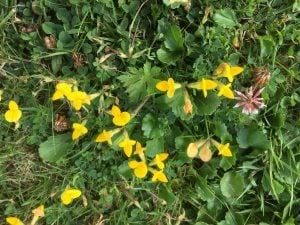
It’s time to go low-mow to help feed our ailing pollinators, says Jean Vernon
Lawns form the heart of most gardens, sometimes taking up half or more of the garden space.
Generally the garden lawn has long been a leisure space, somewhere for the children to play and run, a space for the dog to stretch its legs and the perfect place for a summer picnic or even a spot of sunbathing.
The garden lawn was considered to be a carbon sink, absorbing CO2, which is then fed back to the soil as the leaves rot. But the effort and resources required to keep the lawn green and lush (and stripy) ie. Mostly fertilisers and lawnmowers actually negate the positives and produce more of the dreaded greenhouse gases than the lawn actually soaks up. So horror of horror, your manicured lawn is actually an environmental disaster.
What’s more if it’s stripy, close mown and free from weeds it’s pretty useless for wildlife too. And how many manicured lawns are used for child’s play and summer parties (Keep off the lawn signs anyone??). It’s time to rethink the quintessential British lawn.
Artificial monstrosities
But that’s no excuse for artificial grass, a heinous invention that was fine lining the shelves at the greengrocers and maybe, just maybe in a tiny rooftop garden design where heavy turf is a no-no, but never ever instead of real live plants, ever, please.
But even a highly manicured lawn, treated with weed, feed and moss killing products is not a habitat of choice, or a source of food for our wildlife. If you consider that an estimated 10 million acres of land in the UK is made up of gardens large and small and that a conservative estimate that half of each garden is a lawn, then that’s an astonishing area.
Grass monocultures
Tightly manicured lawns that are rich in just lawn grasses and devoid of any other plant species, wildflowers or weeds, (depending on your opinion), have nothing to offer our pollinators. Frankly these are sterile landscapes, time consuming monocultures that have no place in most gardens. A bowling green effect is fine for a small area, but let the grass grow longer, nurture the wildflowers that are naturally in the seed bank of your garden soil and let them flower. For it is the higher percentage of nectar rich wildflowers in a lawn that can make all the difference to early emerging creatures desperately searching for sustenance on warmer spring days.
Go Low-Mow
You can make your lawn greener and save time, effort and money by going low-mow. Who wants to spend hours each week mowing the lawn? Designate a formal lawn area if you must, but let the sward grow longer and let the ground hugging wildflowers, flower. The daisies, the self heal, the clover and buttercups all offer precious nectar and pollen through the seasons and bolster the food sources of hedges, meadows and woodlands. A wildflower lawn looks natural and soft and totally beautiful. Mow short cut paths through it to allow access to all areas of the garden. Then sit back and enjoy the plants that appear. Weed out the nettles and docks by all means, but add plug plants of wild flowers to bolster the effect and watch the wildlife return to your plot.
Our gardens have got to be the food banks for wildlife if we are to reverse the catastrophic effects of habitat loss on insects, birds and mammals. Don’t pave them over, make them smaller, create more flower borders, plant more flowers and make your lawns richer in flowers and better for wildlife.


